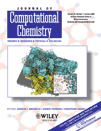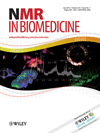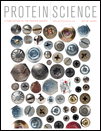
JOURNAL OF BIOMOLECULAR NMR
Scope & Guideline
Exploring the forefront of biomolecular NMR research.
Introduction
Aims and Scopes
- NMR Methodologies:
The journal emphasizes advancements in NMR techniques, such as relaxation dispersion, solid-state NMR, and multi-dimensional NMR, which are critical for studying complex biomolecular systems. - Protein Dynamics and Interactions:
Research often centers on the dynamics of proteins, including conformational changes, interactions, and folding mechanisms, which are essential for understanding biological functions. - Isotope Labeling Techniques:
A consistent focus on innovative protocols for isotope labeling of biomolecules, facilitating detailed NMR studies of proteins and nucleic acids. - Application of Machine Learning:
Increasingly, the journal explores the integration of machine learning techniques to enhance data analysis and interpretation in NMR spectroscopy. - Biomolecular Applications:
The journal showcases studies that apply NMR to solve biological problems, including drug binding, protein aggregation, and the structural biology of membrane proteins.
Trending and Emerging
- In-Cell NMR Applications:
Recent papers highlight the optimization of NMR techniques for studying biomolecules in living cells, indicating a growing interest in understanding biological processes in their native environments. - Advanced Isotope Labeling Strategies:
There is a trend toward developing cost-effective and innovative isotope labeling techniques, which are crucial for enhancing the resolution and applicability of NMR studies. - Machine Learning in NMR:
The integration of machine learning and artificial intelligence for data analysis and prediction in NMR is gaining traction, as researchers seek to automate and improve the accuracy of spectral interpretation. - Solid-State NMR Techniques:
Solid-state NMR is increasingly being utilized to study challenging systems such as membrane proteins and amyloid fibrils, reflecting a trend towards exploring complex biological structures. - Biomolecular Dynamics and Conformational Studies:
Emerging themes focus on the dynamics of biomolecules, including conformational changes and interactions, which are critical for understanding their biological functions.
Declining or Waning
- Traditional Solvent Suppression Techniques:
As new methods and technologies are developed, traditional solvent suppression techniques are becoming less frequently discussed, indicating a shift towards more sophisticated approaches. - Basic NMR Principles:
There is a noticeable decrease in studies focused solely on foundational NMR principles, suggesting that the community is moving towards more applied and specialized research. - Single-Dimensional NMR Techniques:
The prevalence of single-dimensional NMR studies is waning, as researchers increasingly favor multi-dimensional approaches that provide richer information about molecular interactions.
Similar Journals

CHEMISTRY AND PHYSICS OF LIPIDS
Elevating the discourse on lipid chemistry and its applications.Chemistry and Physics of Lipids is a prestigious and influential journal dedicated to advancing the understanding of lipid chemistry and biophysics. Published by Elsevier Ireland Ltd, it serves as a vital resource for researchers and professionals in the fields of biochemistry, cell biology, and molecular biology. The journal has a strong standing within the academic community, as reflected in its 2023 Scopus rankings, where it places in the 82nd percentile for organic chemistry and maintains significant positions in various biochemistry subfields. Spanning from 1966 to 2024, it fosters a comprehensive discourse on lipid-related research and innovation. As a renowned publication in the Q2 and Q3 quartiles across several categories, it supports the dissemination of high-quality research aimed at elucidating lipid functions and their implications in health and disease. Researchers and students alike will find this journal invaluable for staying updated with the latest developments and trends in lipid research.

Journal of Molecular Structure
Unlocking the secrets of molecular architecture.Journal of Molecular Structure is a premier publication in the field of chemistry, offering a platform for innovative research that spans analytical, inorganic, organic chemistry, and spectroscopy. Published by Elsevier in the Netherlands, this journal is committed to advancing the understanding of molecular architecture and behavior through high-quality, peer-reviewed articles. With its impressive impact factor and a notable Scopus ranking placing it in the top quartiles among its peers, it serves as an essential resource for researchers, professionals, and students alike. The journal's open access options promote the dissemination of knowledge, ensuring that groundbreaking discoveries reach a broad audience. Established in 1967 and projected to continue through 2025, the Journal of Molecular Structure is vital for anyone engaged in the study of molecular interactions and structural analysis.

JOURNAL OF COMPUTATIONAL CHEMISTRY
Harnessing Computational Power for Chemical InsightsThe Journal of Computational Chemistry, published by Wiley, is a premier platform in the fields of computational chemistry and computational mathematics. Established in 1980 and continuing through 2024, this journal serves as an essential resource for researchers, professionals, and students seeking to advance their understanding and application of computational methods in chemical research. With a commendable impact factor and ranking in the top quartile (Q2) for both Chemistry and Computational Mathematics, it boasts impressive Scopus rankings—22nd out of 189 in Computational Mathematics and 102nd out of 408 in General Chemistry, indicating its strong influence within these scientific communities. While it does not offer open access, the Journal of Computational Chemistry remains a vital venue for disseminating groundbreaking research and fostering collaboration in the computational science landscape. For those at the forefront of innovation, staying abreast of the latest findings published here is indispensable for advancing their work in theoretical and applied chemistry.

PROTEINS-STRUCTURE FUNCTION AND BIOINFORMATICS
Pioneering Insights into Protein ResearchPROTEINS - STRUCTURE FUNCTION AND BIOINFORMATICS, published by WILEY, is a leading journal in the fields of biochemistry, molecular biology, and structural biology, recognized for its significant contribution to protein research since its inception in 1986. With its impressive rankings in the Q1 category for Biochemistry and Q2 for both Molecular Biology and Structural Biology in 2023, the journal serves as an essential resource for researchers and professionals seeking to explore the intricate relationships between protein structures and their functions. The journal, based in the United States, operates without an Open Access model, ensuring a curated selection of high-quality peer-reviewed articles that drive innovation and collaboration in the scientific community. Engaging with the robust content of PROTEINS not only bolsters academic scholarship but also opens avenues for groundbreaking discoveries that are pivotal in the advancing field of bioinformatics.

Molbank is an open-access journal published by MDPI, dedicated to the fields of Biochemistry, Organic Chemistry, and Physical and Theoretical Chemistry. Established in 2002, this journal has served as a vital platform for the dissemination of research findings, where researchers and professionals share original articles focusing on molecular chemistry, synthesis, and related studies. With a commitment to open access, Molbank enables global access to scientific knowledge, fostering collaboration and innovation among scientists. While currently categorized in the fourth quartile for its field rankings, it provides a unique opportunity for emerging scholars to contribute to and engage with the scientific community. The journal is based in Switzerland, operating from its office at ST ALBAN-ANLAGE 66, CH-4052 BASEL, SWITZERLAND, and continues to attract submissions until 2024. Researchers, students, and professionals looking to expand their knowledge and participate in the dialogue of current molecular chemistry can benefit significantly from engaging with the content published in Molbank.

JOURNAL OF STRUCTURAL BIOLOGY
Exploring the Complexities of Life at the Molecular LevelJOURNAL OF STRUCTURAL BIOLOGY, published by Academic Press Inc. Elsevier Science, is a prestigious peer-reviewed journal dedicated to advancing the field of structural biology. With an impressive Impact Factor and recognized as a Q1 journal in its category for 2023, it holds a significant position in the academic community, ranked 20th out of 49 in the Scopus Biochemistry, Genetics and Molecular Biology - Structural Biology category. The journal publishes groundbreaking research that contributes to our understanding of biological macromolecules and their complexes, span from 1990 and continuing through 2024. Researchers and professionals alike rely on this journal for high-quality articles that cover a wide array of techniques including X-ray crystallography, NMR spectroscopy, and cryo-electron microscopy. Although it does not operate under an Open Access model, the journal remains a vital resource for those in academia and industry searching for the latest findings and methodologies in structural biology.

BIOCHIMICA ET BIOPHYSICA ACTA-PROTEINS AND PROTEOMICS
Illuminating the Path of Protein FunctionalityBIOCHIMICA ET BIOPHYSICA ACTA-PROTEINS AND PROTEOMICS, published by Elsevier, is a prestigious academic journal that serves as a vital resource for researchers, professionals, and students in the fields of biochemistry, biophysics, and proteomics. With an ISSN of 1570-9639 and an E-ISSN of 1878-1454, this journal features high-impact research articles aimed at advancing our understanding of protein structure, function, and interactions, contributing significantly to both theoretical and applied sciences. Recognized for its quality, it proudly holds a Q1 ranking in Analytical Chemistry and Biophysics, and Q2 in Biochemistry for 2023, alongside notable Scopus rankings that reflect its influence in the realm of molecular biology. The journal's commitment to disseminating essential findings supports the ongoing evolution of proteomic sciences and encourages collaborative discourse among the global scientific community. For aspiring authors, the journal offers open access options, enabling broad visibility of their work. Join the conversation in this dynamic field and contribute to shaping the future of protein research!

JOURNAL OF MOLECULAR BIOLOGY
Innovative Insights into Biophysics and StructureThe Journal of Molecular Biology (ISSN: 0022-2836, E-ISSN: 1089-8638), published by Academic Press Ltd - Elsevier Science Ltd, stands as a premier platform for disseminating significant advancements in the field of molecular biology. With a distinguished history of publication spanning from 1959 to 2024, this journal is recognized for its high-quality, peer-reviewed articles that engage with transformative research in biophysics, structural biology, and molecular biology. The journal holds an impressive Q1 category ranking across these disciplines in 2023, affirming its impact and relevance within the scientific community. Notably, it ranks #11 in biophysics and #5 in structural biology based on Scopus metrics, placing it in the 93rd and 90th percentiles, respectively. As an essential resource for researchers, professionals, and students alike, the Journal of Molecular Biology serves as a vital conduit for the exchange of innovative ideas and discoveries, fostering a deeper understanding of life's molecular underpinnings.

NMR IN BIOMEDICINE
Bridging NMR Techniques with Clinical ExcellenceNMR in Biomedicine is a prestigious journal published by Wiley that has been at the forefront of advancing research in the integration of Nuclear Magnetic Resonance (NMR) techniques within the realms of biomedicine since its establishment in 1988. With its ISSN 0952-3480 and E-ISSN 1099-1492, this journal focuses on the application of NMR across various scientific disciplines, including Molecular Medicine, Radiology, Nuclear Medicine and Imaging, and Spectroscopy. The journal is classified in the Q1 and Q2 quartiles as of 2023, showcasing its significant impact and contribution, particularly in Radiology and Spectroscopy, where it ranks in the top tier of its fields. The Scopus ranks reflect its esteemed position, with notable placements such as #70/333 in Radiology and #25/76 in Chemistry Spectroscopy. While Open Access options are not available, the journal remains committed to providing high-quality, peer-reviewed research that fosters innovation and collaboration within the scientific community. Researchers, professionals, and students are encouraged to explore the cutting-edge findings presented in this journal, as it continues to shape the future of biomedical applications of NMR.

PROTEIN SCIENCE
Advancing the Frontiers of Protein ResearchPROTEIN SCIENCE, published by Wiley, is a premier journal dedicated to the field of biochemistry, molecular biology, and medicine, boasting an impressive impact factor that reflects its influence and importance within the academic community. Established in 1992, the journal has continuously provided a platform for high-quality research, with a current classification in the top quartile (Q1) for its critical contributions to the understanding of protein structure and function, as well as its applications in health and disease. With a Scopus ranking placing it in the 91st percentile among its peers, PROTEIN SCIENCE publishes cutting-edge studies and reviews that are essential for researchers, professionals, and students seeking to advance their knowledge in protein research. Although it does not currently offer open access options, the journal remains dedicated to disseminating vital findings that support the ongoing advancements in molecular biology and biochemistry. Researchers can count on PROTEIN SCIENCE for consistently rigorous peer-reviewed content that fosters meaningful dialog and innovation in the life sciences.